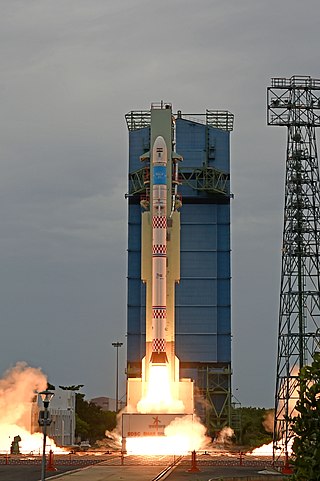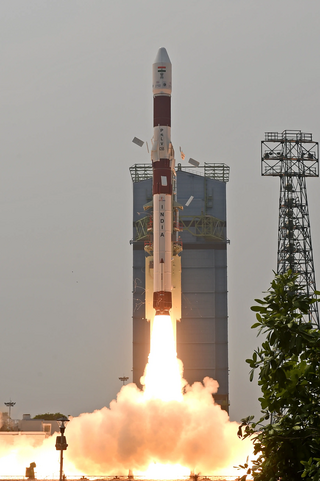
The Polar Satellite Launch Vehicle (PSLV) is an expendable medium-lift launch vehicle designed and operated by the Indian Space Research Organisation (ISRO). It was developed to allow India to launch its Indian Remote Sensing (IRS) satellites into Sun-synchronous orbits, a service that was, until the advent of the PSLV in 1993, only commercially available from Russia. PSLV can also launch small size satellites into Geostationary Transfer Orbit (GTO).

Satish Dhawan Space Centre – SDSC, is the primary spaceport of the Indian Space Research Organisation (ISRO), located in Sriharikota, Andhra Pradesh.
Technology Experiment Satellite (TES) is an Indian remote sensing and photo-reconnaissance satellite.
PSLV-C34 was the 36th mission of the PSLV program and 14th mission of PSLV in XL configuration. The PSLV-C34 successfully carried and deployed 20 satellites in the Sun-synchronous orbit. With a launch mass of 320,000 kilograms (710,000 lb) and payload mass of 1,288 kilograms (2,840 lb), the C34 set a new record of deploying the maximum number of satellites by Indian Space Research Organisation in a single mission. The PSLV-C34 carried One Cartosat-2 satellite, SathyabamaSat, Swayam & 17 other satellites from United States, Canada, Germany & Indonesia.
PSLV-C35 was the successful mission of the Polar Satellite Launch Vehicle program which set eight satellites in space. It was launched on 26 September 2016 by Indian Space Research Organisation (ISRO) from the Satish Dhawan Space Centre at Sriharikota.
PSLV-C1 was the overall fourth mission of the Polar Satellite Launch Vehicle (PSLV) program by Indian Space Research Organisation (ISRO). The vehicle carried IRS-1D satellite which was deployed in the Sun-synchronous orbit (SSO). This was India's first launch vehicle built without Russian assistance and PSLV's first operational flight placed IRS-1D into a polar orbit. However, it could not place the satellite in the desired circular orbit but in an elliptical orbit due to a leak of helium gas from one of the components. The mission was termed partial failure since the satellite could not be placed at the desired altitude.
PSLV-C2 was the second operational launch and overall fifth mission of the Polar Satellite Launch Vehicle (PSLV) program. This launch was also the forty-third launch by Indian Space Research Organisation (ISRO) since its first mission on 1 January 1962. The vehicle carried three satellites which were deployed in the Sun-synchronous low Earth orbit. The vehicle carried India's first remote sensing satellite Oceansat-1 (IRS-P4) as the main payload. It also carried South Korean satellite KITSAT-3 and German satellite DLR-Tubsat as auxiliary payloads. PSLV-C2 was the first Indian Expendable launch vehicle to carry and deploy more than one satellite in a mission. This was also India's and ISRO's first commercial spaceflight where South Korea and Germany each paid US$1.0 million to ISRO for launching their satellites.
PSLV-C4 was the fourth operational launch and overall seventh mission of the PSLV program. This launch was also the forty-eight launch by Indian Space Research Organisation since its first mission on 1 January 1962. The vehicle carried and injected India's first dedicated Meteorological satellite, Kalpana-1 into the Geosynchronous transfer orbit. PSLV-C4 was launched at 15:53 hours IST on 12 September 2002 from Satish Dhawan Space Centre.
PSLV-C5 was the fifth operational launch and overall eighth mission of the Polar Satellite Launch Vehicle program. This launch was also the fifty-second launch by the Indian Space Research Organisation (IRSO) since its first mission on 1 January 1962. The vehicle carried and injected India's remote sensing satellite Resourcesat-1 into a Sun-synchronous orbit; this was the heaviest and most sophisticated satellite built by IRSO through 2003. PSLV-C5 was launched at 04:52 hours Coordinated Universal Time on 17 October 2003 from Satish Dhawan Space Centre.

PSLV-C6 was the sixth operational launch and overall ninth mission of the PSLV program. This launch was also the fifty-fourth launch by Indian Space Research Organisation since its first mission on 1 January 1962. The vehicle carried and injected India's two satellites; Cartosat-1 and HAMSAT into the Sun-synchronous orbit. PSLV-C6 was launched at 04:44 hours Coordinated Universal Time on 5 May 2005 from the second launch pad of the Satish Dhawan Space Centre.

PSLV-C37 was the 39th mission of the Indian Polar Satellite Launch Vehicle (PSLV) program and its 16th mission in the XL configuration undertaken by the Indian Space Research Organisation (ISRO). Launched on 15 February 2017 from the Satish Dhawan Space Centre at Sriharikota, Andhra Pradesh, the rocket successfully carried and deployed a record number of 104 satellites in Sun-synchronous orbits in a single mission, breaking the earlier record of launching 37 satellites by a Russian Dnepr rocket on 19 June 2014. This record was held until the launch of the Transporter-1 mission by SpaceX on 24 January 2021 which launched 143 satellites.

The Small Satellite Launch Vehicle (SSLV) is a small-lift launch vehicle developed by ISRO with payload capacity to deliver 500 kg (1,100 lb) to low Earth orbit or 300 kg (660 lb) to Sun-synchronous orbit for launching small satellites, with the capability to support multiple orbital drop-offs. SSLV is made keeping low cost, low turnaround time in mind with launch-on-demand flexibility under minimal infrastructure requirements.

The PSLV-C43 was the 45th mission of the Indian Polar Satellite Launch Vehicle (PSLV) program. It carried and deployed a total of 31 satellites, including the primary payload HySIS in Sun-synchronous orbits. It was launched on 29 November 2018 by the Indian Space Research Organisation (ISRO) from the first launch pad of the Satish Dhawan Space Centre at Sriharikota, Andhra Pradesh.

The PSLV-C44 was the 46th mission of the Indian Polar Satellite Launch Vehicle (PSLV) program. It was the first flight of PSLV-DL, having 2 strap-on boosters and placed a primary payload Microsat-R and a secondary payload of Kalamsat V2 in Sun-synchronous orbits.

The PSLV-C55 was the 57th mission of Indian Space Research Organisation's Polar Satellite Launch Vehicle (PSLV) and the 16th flight of the PSLV-CA variant.

PSLV-C46 was a mission of the Indian Polar Satellite Launch Vehicle (PSLV) rocket, launched on Thursday, May 22, 2019, at 05:30 Hrs (IST) by the Indian Space Research Organisation (ISRO) from the first launch pad of the Satish Dhawan Space Centre at Sriharikota, Andhra Pradesh. In this mission, the 'Core-Alone' configuration of PSLV was flown.

PSLV-C7 was a mission of the Indian Polar Satellite Launch Vehicle (PSLV) rocket, launched on January 10, 2007, by the Indian Space Research Organisation (ISRO) from the Satish Dhawan Space Centre at Sriharikota, Andhra Pradesh.

The PSLV C-58 was the 60th flight of the Indian Space Research Organisation's Polar Satellite launch Vehicle. It carried the XPoSAT mission along with rideshare payloads.













